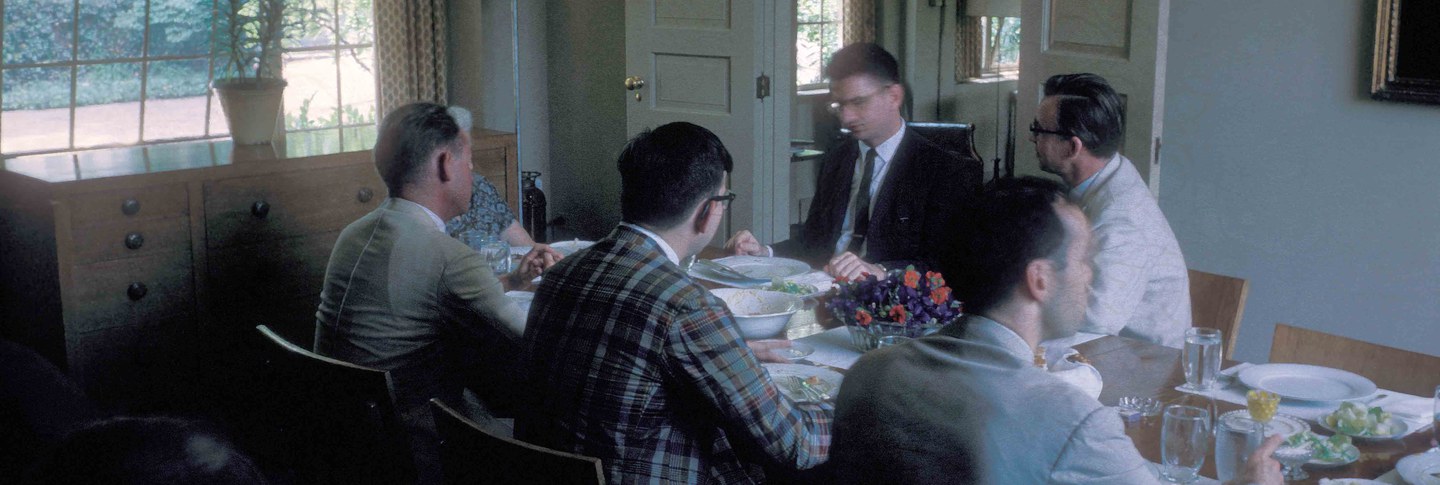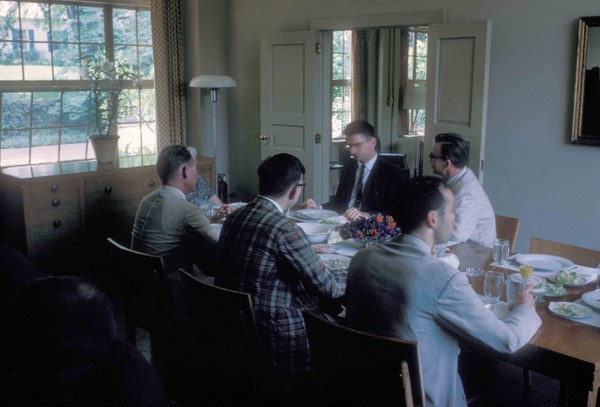Dining in the Fellows Building, 1964.
From the inception of the Dumbarton Oaks Research Library and Collection, communal meals at lunchtime were seen to be a quintessential part of the daily activity. Faculty (when they existed), fellows, visitors, and later the entire staff had lunch together in the Fellows Building, and in the twenty-first century, the custom continues in the new Refectory. It was at these meals that the entire range of academia at Dumbarton Oaks, from the most renowned professors to graduate students just beginning their careers, might mingle with one another. It was also here that deep personal bonds might be forged over a shared meal and conversation, and for those reasons, dining in the Fellows Building greatly enhanced the experience of many engaged in research at Dumbarton Oaks.
Sharing a meal at the Fellows Building provided the nexus for interaction, especially between individuals at different stages of their careers. Pre-Columbian senior fellow J. Scott Raymond commented that the first interactions he often had with the fellows and junior fellows (whom he helped select) would be in the Fellows Building over lunch. He noted that by having a communal lunch, senior fellows were at the very least able to get acquainted with the rising scholars. Another Pre-Columbian senior fellow, Christopher Donnan, had fond memories of the conversations that took place in the Fellows Building between himself and the developing academics, saying, “It was a good social time, with Dumbarton Oaks style.”

Appreciation of mealtime interaction went both ways, and younger scholars found their mealtimes to be equally meaningful. Byzantinist John Duffy described the excitement and intimidation that he initially felt in speaking with the “luminaries at the table at lunchtime” noting that he eventually found them “very friendly.” Pre-Columbianist Joanne Pillsbury commented on the importance of mealtime interaction with the senior scholars during her time as a junior fellow. She called the experience critical to the development of her career, saying that she remembered being seated next to John Rowe at a dinner held the night before a symposium. Pillsbury admitted that at first she was “terrified to sit next to him at dinner,” but that she rapidly found him to be “absolutely wonderful.” Pillsbury acknowledged that Rowe became her “great unofficial mentor” because of the interaction, which she called “more than just simply dinner” for its ability to, in her words, “transform a young scholar’s career.”
Cyril Mango echoed these sentiments: “We scholars all gathered together at lunch and dinner,” regardless of the length of time one was staying. Mango credited this with enabling those studying at Dumbarton Oaks “to know a wide range of people,” including “eminent” persons.
Beyond promoting conversations between scholars at varying stages of their careers, meals in the Fellows Building also fostered discussions between members of different academic fields. Former fellow (now senior fellow) in the Garden and Landscape Studies program Mark Laird called interdisciplinary mixing in the Fellows Building “adventitious,” noting that it depended on “who was there and whom you happened to run across.” It was true, he asserted, that you would get to know people working in different fields, even if just at “a level of private socialization.”
Joanne Pillsbury supported Laird’s claim, saying: “You really mixed it up a lot more at lunch. It was very cramped here for lunch, so you sat wherever there was a seat.” She noted that it was impossible to go to lunch with a group of people and expect to sit with them because of the restricted table layout. Former junior and later senior fellow in Pre-Columbian Studies Rebecca Rollins Stone summarized aptly her feelings about lunch with colleagues from other disciplines: “I really liked meeting the people that I met.”
In addition to discussions among academics, the Fellows Building meals made dialogue possible between scholars and the staff of Dumbarton Oaks, particularly after Giles Constable became director in 1977, in which capacity he would serve until 1984. As director, Constable opened up the Fellows Building to the entire staff as one of his first acts. He remembered:
Of course, when I went there, the memory of Mrs. Bliss serving tea and Sirarpie Der Nersessian presiding at the lunch table and ringing the bell for the servants to come in was still there. I mean, she no longer did—and Sirarpie wasn’t alive either—but there was the memory. And there was this rather strong and not altogether bad sense of being one large family with a number of family retainers. But that is not the basis upon which a serious scholarly institution can run. And on the straightforward level, one of my first initiatives was to open up the Fellows Building. But even so, the feelings of resentment were so great that some of the staff would never come to lunch.
Ioli Kalavrezou (Harvard Dumbarton Oaks Professor, former junior fellow, and longtime member of the Byzantine Studies senior fellows committee) reflected on Constable’s work to “democratize” Dumbarton Oaks. She reminisced on the first meeting that he had, saying:
He called everybody, everybody. It was all the staff, from the gardeners to the Junior Fellows. And he talked about Harvard and the new policies and democratization and equality. It became a kind of—I don’t know what to call it—a new air about Dumbarton Oaks. The old hierarchical lifestyle in the Main House, with the nice couches and the tea-serving sort of things were going to be a thing of the past.
And it was immediately after this meeting that the entirety of the Dumbarton Oaks staff was able to dine in the Fellows Building.
With its ability to unite so many, dining in the Fellows Building began to interest other institutions that sought to mirror Dumbarton Oaks’ success in fostering an academic community. Ioli Kalavrezou noted that visitors from the National Gallery came to lunch at the Fellows Building and speculated that they likely wanted to examine how Dumbarton Oaks functioned as they prepared for their own research institute, the Center for Advanced Study in the Visual Arts (CASVA), which was founded in 1979.

The time that fellows, visitors, and staff share together in the dining hall is a significant component of the community that is Dumbarton Oaks. Byzantinist Hans Belting called the Fellows Building “the real center of Dumbarton Oaks.” Communal meals in the Fellows Building provide opportunities for meaningful discussions that have contributed to the advancement of careers, fostered exchanges between adherents of different academic schools, and, importantly, cultivated friendships between colleagues. Belting awarded the Fellows Building the highest honor when he said in an interview at the Fellows Building that “the biggest impression I got from Dumbarton Oaks was in this room.”

